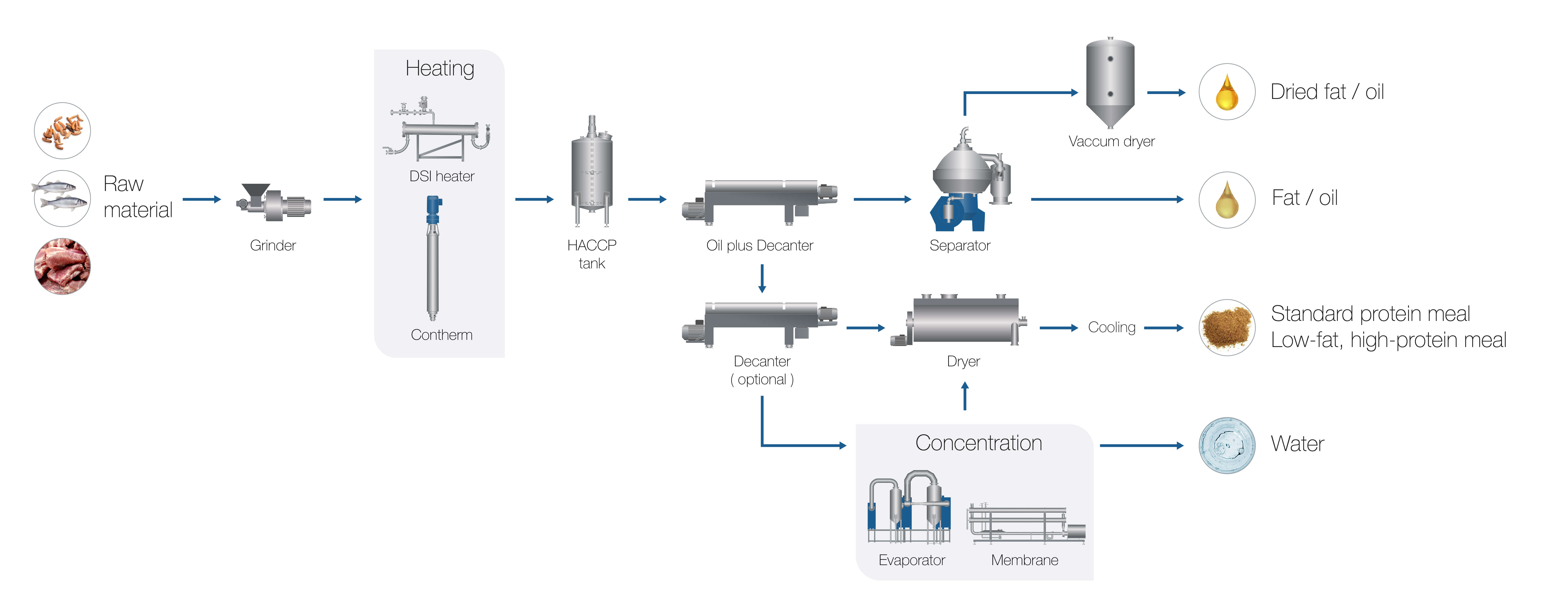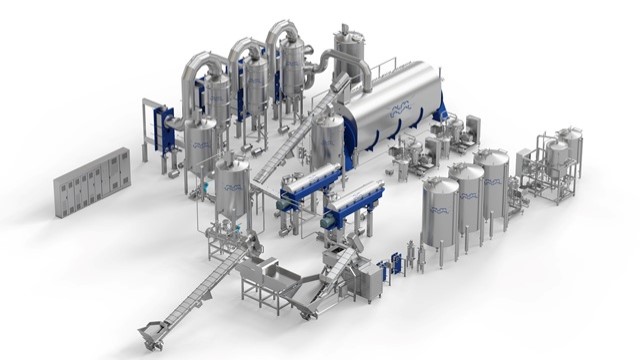Centriflow Wet Rendering System
Få mer verdi ut av råvarene dine med Alfa Laval Centriflow-våtrenderingssystem. Omdann insekter og biprodukter fra kjøtt, fjærkre eller fisk til fett og proteiner av høy verdi for bruk i mat eller fôr. Centriflow øker utbyttet, reduserer dampforbruket og senker karbonavtrykket. I tillegg hjelper det deg med å utvinne mer, sløse mindre og øke lønnsomheten.
Oppsirkuler ferske råvarer på stedet og behold mer verdi internt
- Høyere fettutbytte, magrere proteiner
- Reduser dampforbruket
- Styrk bærekraftsprofilen din
- Maksimer lønnsomheten ved oppsirkulering på stedet
- Minimer avhengigheten av tredjeparts smelteselskaper
Øk fettutbyttet av høy kvalitet og få proteiner av høyere kvalitet fra hver porsjon. Sammenlignet med konvensjonelle systemer kan Alfa Laval Centriflow Wet Rendering System levere omtrent 10 % mer fett – samtidig som det produserer proteiner av høyere kvalitet.
Den skånsomme, lavtemperaturbehandlingen til dette våtsmeltesystemet bidrar til bedre farge, produktstabilitet og totalt utbytte. I motsetning til andre metoder fjerner den vann gjennom sentrifugalseparasjon og effektiv fordampning – og reduserer dampforbruket med opptil 40 %.
Centriflow er kompakt, fleksibel og enkel å skalere, og gjør det enkelt å oppsirkulere råmaterialer på stedet, noe som reduserer avhengigheten av tredjeparts renderingselskaper.
Bygget for sømløs integrasjon. Dokumentert ytelse. Utviklet for å levere mer.
Utvinn mer fett, proteiner av høyere kvalitet – og maksimer avkastningen
Alfa Laval kombinerer dyp bransjeekspertise med velprøvd teknologi for prosessering av animalske biprodukter for å støtte din suksess. Enten du designer et nytt anlegg, skalerer opp, oppgraderer eller optimaliserer driften, hjelper ekspertene våre deg med å fremtidssikre prosessene dine. Lås opp mer. Sløs mindre. Voks bærekraftig.
Kjøttforedling
Frigjør det fulle potensialet til kjøttbiproduktene dine. Gjenvinn proteiner og fett av høy kvalitet til kjæledyrfôr, dyrefôr og matingredienser – og få ekstra verdi ut av hvert kutt.
Få mer verdi ut av hvert kutt – enten du driver et slakteri eller et smelteanlegg. Alfa Laval Centriflow hjelper deg med å gjøre kjøttbiprodukter om til profitt. Dette systemet produserer høyrent fett, smult eller talg som er lyse i fargen, lukter lite og har lavt innhold av frie fettsyrer – ideelt for mat- eller fôrbruk. Den leverer også magre proteiner med lavt fuktighetsinnhold som er enkle å håndtere og tiltrekker seg høyere verdi på markedet.
Behandling av fjærkre
Generer mer inntekter fra fjærkrebiprodukter ved å utvinne fett og proteiner av høy kvalitet til kjæledyrfôr, dyrefôr og matvareingredienser .
Gjør fjærkrebiprodukter om til produkter med høy verdi. Centriflow muliggjør effektiv gjenvinning av lyst fjærkrefett med lavt innhold av frie fettsyrer (FFA) og proteiner av høy kvalitet – ideelt for bruksområder som protein og olje av næringsmiddelkvalitet, samt kjæledyrfôr og dyrefôr. Uansett om målet ditt er å redusere avfall, øke inntekter eller oppfylle strenge produktspesifikasjoner, hjelper Centriflow deg med å få mer ut av råmaterialet ditt.
Fiskeforedling
Gjør fiskebiprodukter om til produkter med høy margin, for eksempel omega-3-oljer og proteiner til kjæledyrfôr, dyrefôr,akvakulturfôr eller til og med matingredienser.
Maksimer avkastningen fra hver fangst. Enten du foredler laks, hvitfisk eller pelagiske arter, hjelper Alfa Laval Centriflow deg med å gjenvinne omega-rike oljer og proteiner av høy kvalitet – samtidig som du reduserer avfall, energiforbruk og vannforbruk. Fra håndtering av råvarer til ferdig produkt er Alfa Lavals systemer bygget for pålitelighet, ytelse og enkel integrering i nye og eksisterende linjer.
Bearbeiding av insekter
Øk marginene dine ved å utvinne lipider og næringsrike proteiner fra insekter.
Lås opp mer fra hver parti. Alfa Laval Centriflow ekstraherer effektivt lipider og proteiner fra sirisser, melormer eller svarte soldatfluelarver. Skånsom varmebehandling og hygienisk design bevarer produktkvaliteten og næringsverdien. Fra pilotprosjekt til fullskalaproduksjon hjelper vi deg med å finjustere ytelsen, skalere trygt og tilpasse en løsning som dekker dine behov.
Slik fungerer Centriflow-våtrenderingssystemet

Alfa Laval Centriflow bruker en skånsom, lavtemperatur våtrenderingsprosess for å maksimere produktkvaliteten og verdien fra insekter og biprodukter fra kjøtt, fjærkre og fisk.
Tilberedning av råvarer
Råmaterialet kan tilføres gjennom ulike metoder. Før bearbeiding går den gjennom en metalldetektor, hvis tilgjengelig, for å sjekke for forurensninger. Hvis systemet oppdager metall, avviser det den delen for å beskytte kvernen og nedstrømsutstyret. Når råmaterialet er renset, går det inn i kvernen, hvor det kuttes til ideell størrelse for effektiv oppvarming i neste trinn.
Oppvarmingsprosess
En pumpe overfører produktet, som nå er redusert i størrelse, for oppvarming til enten: (1) en Alfa Laval direkte dampinjeksjonoppvarmer (DSI), eller (2) en Alfa Laval Contherm-skrapevarmeveksler for indirekte dampoppvarming.
Separering
Det forhåndsoppvarmede produktet går inn i en to- eller trefaset dekantersentrifuge, avhengig av råmaterialet. Dekanteren separerer produktet i en solid fase, en væskefase (limvann) og fett/olje.
Limvannet og fett samles i separate buffertanker, som vanligvis er utstyrt med direkte dampinjeksjonsdyser eller varmekjeler med omrørere for å opprettholde optimale forhold.
Fettklaring og bearbeiding av limvann
Limvannet, som fortsatt inneholder noe fett, kan gjennomgå ytterligere klaring (valgfritt) i en separator for å fjerne gjenværende fett. Fettet fra buffertanken sendes også til en separator for videre rensing.
Limvannkonsentrasjon og tørking
En AlfaVap platefordamper konsentrerer det avfettede limvannet ved hjelp av:
- termisk dampkompresjon (TVR)
- mekanisk damprekompresjon (MVR)
- spillvarme fra tørkeren
Det konsentrerte limvannet blandes deretter med dekanterfaststoffer og sendes til tørkeren for endelig bearbeiding.
Endelig oljetørking
Den rensede oljen fra separatoren blir ofte behandlet i en vakuumtørker, noe som reduserer fuktighetsinnholdet for å oppnå høyeste kvalitet.
Fornøyde kunder
Dokumenter
Last ned
Service
Matsystemtjenester
Matsystemtjenester
Alfa Laval-matsystemtjenester bidrar til å utvide ytelsen til matsystemene dine ved å maksimere ytelsen til prosessene. Dette gjør at du kan:
- Forbedre driften din kontinuerlig for å opprettholde konkurransefortrinn
- Fokusere på oppetid, optimalisering og tilgjengelighet
- Maksimere avkastningen på investeringen gjennom hele livssyklusen til matsystemene dine

